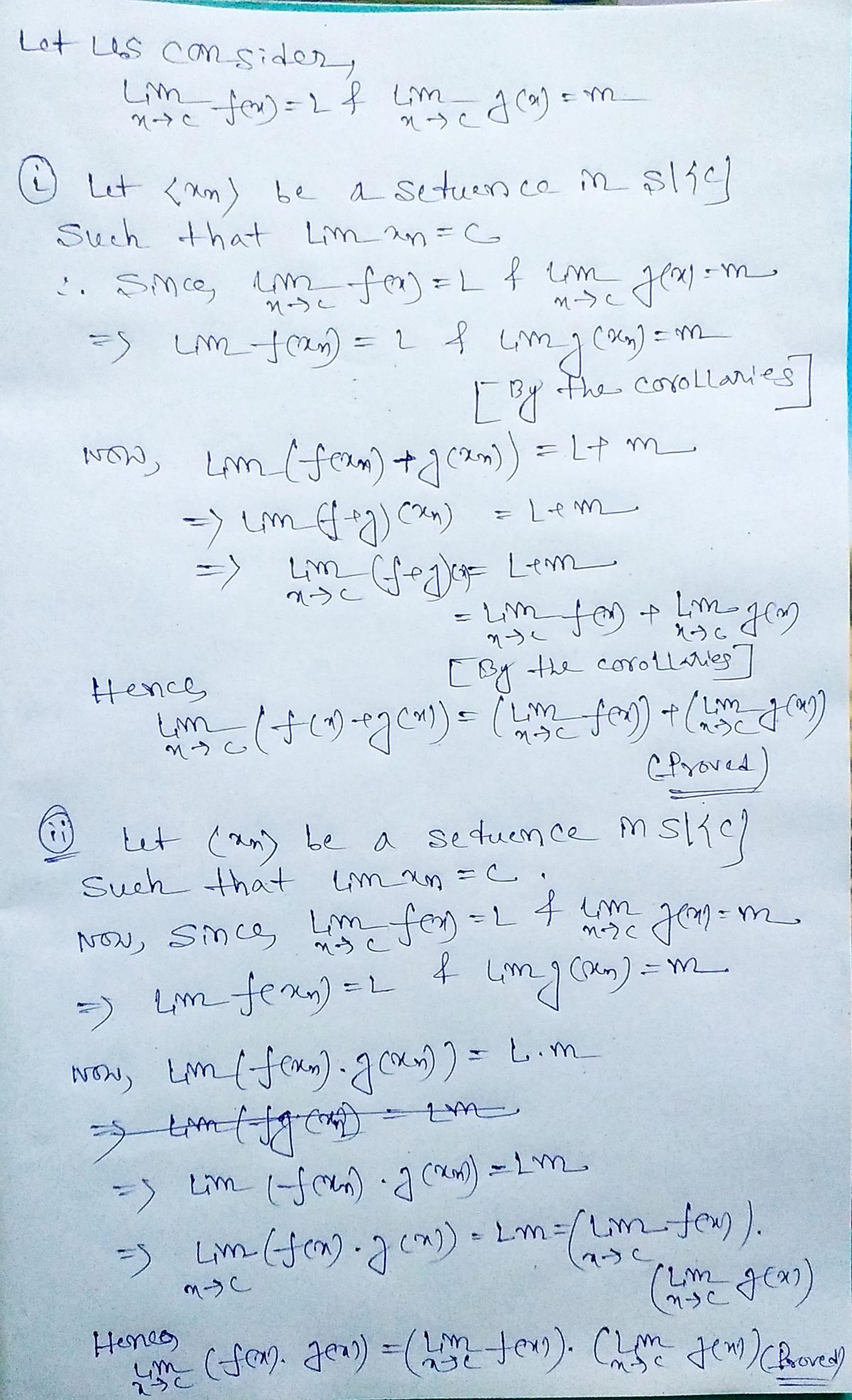(a) (Continuity of algebraic operations) Let S C R and c be a cluster point of S. Let f: S→ R and g: S→ R be functions. Suppose limits of f(x) and g(x) as x goes to c both exist. Prove that (i) lim (ƒ(x) + g(x)) = (lim ƒ(x)) + (lim g(x)) x→C Lemma 3.1.7. Let SCR and c be a cluster point of S. Let f: S→R be a function. Then f(x)→ Las x→c if and only if for every sequence {xn} of numbers such that xn = S\{c} for all n, and such that lim xn=c, we have that the sequence {f(xn)} converges to L. (i) lim (f(x) + g(x)) = (lim f(x)) + (lim g(x)) x→C (ii) lim (f(x)g(x)) = (lim ƒ(x)) (lim g(x)) X→C (iii) If lim g(x) ‡ 0 and g(x) ‡ 0 for all x € S \ {c}, then x→C f(x) lim x+c g(x) = limx→c f(x) limx→c g(x)
(a) (Continuity of algebraic operations) Let S C R and c be a cluster point of S. Let f: S→ R and g: S→ R be functions. Suppose limits of f(x) and g(x) as x goes to c both exist. Prove that (i) lim (ƒ(x) + g(x)) = (lim ƒ(x)) + (lim g(x)) x→C Lemma 3.1.7. Let SCR and c be a cluster point of S. Let f: S→R be a function. Then f(x)→ Las x→c if and only if for every sequence {xn} of numbers such that xn = S\{c} for all n, and such that lim xn=c, we have that the sequence {f(xn)} converges to L. (i) lim (f(x) + g(x)) = (lim f(x)) + (lim g(x)) x→C (ii) lim (f(x)g(x)) = (lim ƒ(x)) (lim g(x)) X→C (iii) If lim g(x) ‡ 0 and g(x) ‡ 0 for all x € S \ {c}, then x→C f(x) lim x+c g(x) = limx→c f(x) limx→c g(x)
Advanced Engineering Mathematics
10th Edition
ISBN:9780470458365
Author:Erwin Kreyszig
Publisher:Erwin Kreyszig
Chapter2: Second-order Linear Odes
Section: Chapter Questions
Problem 1RQ
Related questions
Question
Prove the following corollaries to the sequential limits lemma

Transcribed Image Text:(a) (Continuity of algebraic operations) Let S C R and c be a cluster point of S. Let
f: S→ R and g : S → R be functions. Suppose limits of f(x) and g(x) as x goes to c
both exist. Prove that
(i) lim (f(x) + g(x)) = (lim f(x)) + (lim g(x))
X→C
Lemma 3.1.7. Let SCR and c be a cluster point of S. Let f: S→ R be a function.
Then f(x)→ Las x→c if and only if for every sequence {xn} of numbers such that xn S\ {c}
for all n, and such that lim xn=c, we have that the sequence {f(xn)} converges to L.
(i) lim (f(x) + g(x)) = (lim f(x)) + (lim g(x))
x→C
(ii) lim (f(x)g(x)) = (lim f(x)) (lim g(x))
x→C
(iii) If lim g(x) ‡ 0 and g(x) ‡ 0 for all x € S \ {c}, then
x→C
f(x)
lim
xc qx
=
limx→c f(x)
limx→ 9(x)
Expert Solution
Step 1

Step by step
Solved in 2 steps with 2 images

Recommended textbooks for you

Advanced Engineering Mathematics
Advanced Math
ISBN:
9780470458365
Author:
Erwin Kreyszig
Publisher:
Wiley, John & Sons, Incorporated

Numerical Methods for Engineers
Advanced Math
ISBN:
9780073397924
Author:
Steven C. Chapra Dr., Raymond P. Canale
Publisher:
McGraw-Hill Education

Introductory Mathematics for Engineering Applicat…
Advanced Math
ISBN:
9781118141809
Author:
Nathan Klingbeil
Publisher:
WILEY

Advanced Engineering Mathematics
Advanced Math
ISBN:
9780470458365
Author:
Erwin Kreyszig
Publisher:
Wiley, John & Sons, Incorporated

Numerical Methods for Engineers
Advanced Math
ISBN:
9780073397924
Author:
Steven C. Chapra Dr., Raymond P. Canale
Publisher:
McGraw-Hill Education

Introductory Mathematics for Engineering Applicat…
Advanced Math
ISBN:
9781118141809
Author:
Nathan Klingbeil
Publisher:
WILEY

Mathematics For Machine Technology
Advanced Math
ISBN:
9781337798310
Author:
Peterson, John.
Publisher:
Cengage Learning,

